#a general introduction to psychoanalysis
Explore tagged Tumblr posts
Text
Freud talks a lot about "primitive languages" for someone who's clearly only interacted with German and English-speaking pts.
#freud#sigmund freud#a general introduction to psychoanalysis#psychoanalysis#quackery#I mean - I'm reading this because I thought it'd be funny#and I was mostly right#the dream stuff is hilarious#but he sure finds ways to crowbar the racism in there at random#I don't know what I expected#he was an old white guy in psych#I had to attend lectures by a guy who worshipped him#and he sucked#guess what language he's calling an expression of primitive thought#hint - he doesn't know what the fuck he's talking about#racism#“medical” racism#“medicine”
1 note
·
View note
Text
monster theory reading list
this list is going to be some recommended reading when it relates to literary teratology or monster theory. some of these works predate 'monster theory' as a concept (which was coined in 1996 by jeffrey jerome cohen) but are foundational to that work regardless.
i'll try to include links to any readings that are freely available online and links to doi etc but if something isn't and you're really keen, hit me up and y'know we'll see what i can do.
monster theory: reading culture (1996) by jeffrey jerome cohen - the original and defining text on monster theory by the man himself. here is a link to a pdf of the first chapter, which i spoke about at length in another post.
the horror reader (2000) by ken gelder (editor) - an incredibly insightful collected edition about the horror genre as a whole, however gelder's introduction to part three, as well as marie-hélene huet's chapter introduction to monstrous imagination were incredibly helpful to my work personally. very generously, gelder has allowed free access to the entire work in pdf form!
the monster theory reader (2020) by jeffrey andrew weinstock - an amazing collected edition featuring cohen, creed, kristeva and a number of others that provides a really good foundational background knowledge of what contributed to the creation of monster theory as well as some fantastic takes on it post cohen.
classic readings on monster theory (2018) by asa simon mittman & marcus hensel - similar to weinstock, this collected edition features a number of classical foundational essays and some more modern ones surrounding monster theory. a very helpful starting point! here is a link to the introductory chapter by mittman and hensel in pdf form!
the monstrous feminine: film, feminism, psychoanalysis (1993) by barbara creed - creed's idea of the monstrous feminine is one of the foundational underpinnings of monster theory and is key in comprehending the 'other' as monstrous, particularly as it relates to women in a patriarchal society. highly recommend! here is the entire book in pdf form!
powers of horror: an essay on abjection (1982) by julia kristeva - kristeva's idea of abjection is a precursor to a lot of theoretical frameworks regarding the horror genre, in particular as a direct precursor to creed's work, then to cohen's work. here is the entire book in pdf form!
this is definitely not an all encompassing list of sources, but it is a good starting point for anyone interested in this particular niche field of literary theory. these are texts that were crucial for me in understanding the basics when i was starting work on my thesis.
#monsteracademia#monster theory#jeffrey jerome cohen#barbara creed#julia kristeva#ken gelder#jeffrey andrew weinstock#literary theory#literary teratology#monster theory 101
157 notes
·
View notes
Text
[4.0]: A Theory On Rhinedottir, Alchemy, and the Meaning of Sin
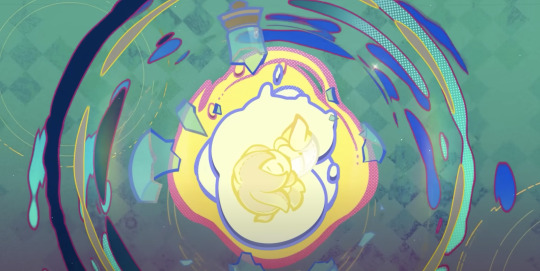
“One thought may end all calamity, and there will always be thoughts that may transcend time.” -The Meaning of Aeons “Separate the dust in the flames with joy, and extract the exquisite from the crude. For all in the universe comes from a single source, and all things may be derived from a single thought.” -Cinnabar Spindle
I’ve been wanting to do some Rhinedottir speculations for a while. With the new Ancient Colors world quest in Fontaine, I think now is a good time to propose a theory about this mysterious member of the Hexenzirkel, her approach to alchemy, and the reason she is a “sinner,” especially within the context of one of the Archon Quest’s central questions: what does it mean to be “born with sin”?
SPOILERS: Up to Act II of the Fontaine AQ (just Primordial Sea stuff), and Ancient Colors.
Although Rhinedottir is never mentioned by name in Ancient Colors, all of the signs of her are there: Mamere’s identity as an artist, Elynas’ otherworldliness and similarities to Durin, and the differences between the Melusine’s perception of the world and our perception of it (or their aesthetics, which we will touch on later). Ancient Colors is trying to remind us of Dragonspine and, if you were playing during this time, Shadows Amidst Snowstorms, and I believe it is doing so because it is key to the secret of the Primordial Sea and the prophecy of Fontaine.
We’ve heard Rhinedottir’s perspective only twice so far, and that was in the Windblume festival from this last year and in Cinnabar Spindle’s lore. Though we still don’t know much about her, she does identify herself as a “mother” of many children, and that she is raising the only son she has left. This, of course, is Albedo.
We also know that she is considered a "sinner" at the center of the Cataclysm who unleashed "an army of shadowy monsters" onto Teyvat, but we have very little grasp of what exactly is meant by "sinner," and what if any consequences this label has had on her since then. Although every Hexenzirkel witch will undoubtedly be very important to uncovering the truth of Teyvat, Rhinedottir presents a particularly interesting case as the only one whose activities may have caused cataclysmic destruction, as opposed to Alice's general mischief and strange sense of humor.
It’s almost nothing to go off of, but I hope to demonstrate in this speculative theory that it’s more than enough to arrive at some answers.
Psychoanalysis 101, Round 2
To better explain what Durin, Elynas, and Rhinedottir’s other children are, we need to use an analogy rooted in Freud’s psychoanalytic theory of dream interpretation. This is a super TL;DR version of it and way oversimplified, but if you’re interested I wrote a more detailed theory about the significance of dreams in Genshin that has a full explanation of it there. (Also, it should be said that these were just Freud’s theories, please do not take any of the following as an accurate description of the human psyche and how it works. We are just having some fun for the sake of media analysis.)
Freud thought that dreams are the mind’s means of expressing unfulfilled wishes, and that the psychological purpose of dreaming is to “fulfill” those wishes. In A General Introduction to Psychoanalysis, he gives an example of this through a little girl’s dream where she was sailing on a lake: this dream was born out of an unfulfilled wish in her waking life, where she had to stop sailing on the lake despite wishing to continue. Hence, “I wish to sail on the lake” becomes “I am sailing on the lake” through the dream.
Further, Freud thought these unfulfilled wishes are “forgotten” in our unconscious mind when we are awake, censored by the ego to protect our conscious mind, but that at night this censorship is weakened. This is what allows a dream to occur while we sleep.
These unfulfilled wishes are often more complicated than a childish wish to keep sailing on a lake. Think about it this way: a wish is, at its core, a thought in our head, or a desire. What do we do with the thoughts we don’t like, the ones that are unbecoming of us or are unacceptable to fulfill?
We deny them.
Specifically, we repress them into the unconscious, where they are forgotten. Thing is, even if we temporarily forget these thoughts, they won’t just disappear from existence - they fester in the unconscious, waiting to be expressed. The dream, therefore, is the unfulfilled wish/repressed thought’s attempt to cross the boundary from the unconscious mind into the conscious mind - to be acknowledged, or indeed remembered.
“Unfulfilled Wishes”
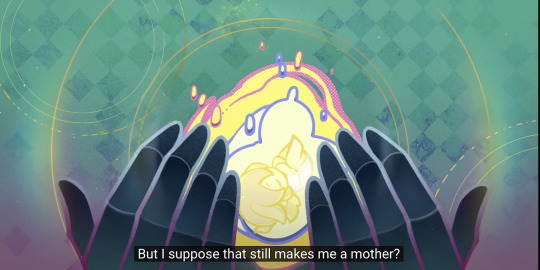
Making sense so far? If so, try to think of Teyvat like this: everything that is visible, everything above ground that the light touches and that can be perceived is like the ego and conscious mind. All of these things are what you’re aware of, things that you “know” and can make sense of, things that you understand, things that fit into rules and laws and order.
Now, think of everything in Genshin that is “unseen” and “unknown”: the Abyss, the spaces underground, forbidden knowledge, things that are “not from this world,” from beyond the firmament…these are like things from the unconscious mind, the repressed thoughts that we deny in ourselves because they may reveal a truth we are unwilling to face. These things are comparatively chaotic in nature, things we’d rather avoid, or things that we wish to forget.
We know that Elynas’ and Durin’s bodies are composed of matter that’s foreign to Teyvat, and that this is a major reason why they are incompatible with Teyvat and cause its destruction. This would make them more similar to a repressed thought, something that we don’t understand or know, and attempting to understand it destabilizes our sense of self, our “truth.” It follows that their home, the Abyss, is most similar to our unconscious mind, and Teyvat is most similar to our conscious mind.

Elynas: Before I was born, I floated in the cosmic darkness. It was cold there, and lonely. I was so sad, then, and I would often cry.
So, as their mother, who or what is Rhinedottir in this analogy? Well, we can be a lot more specific than calling her a “sinner.” In fact, she’s a dreamer, and alchemy is the medium through which she “dreams”:
This was a story from long ago... Unborn life, unfulfilled wishes, Tragic dreams at the edge of the universal darkness that could never come true, Indwell my body, and descend unto this world. Then, my lovely children, Like rainwater flowing into creeks, and plants growing towards the sun, Go unto a lovely place, and display your own beauty there with pride. This is a memory, a memory that a child named Durin had of his mother… "Thank you, Mother, thank you." "You gave me wings to soar and a mighty form." "Mother, I wish to go to a land of lovely songs," "I will tell them about you, Mother, and about everyone else." "I shall tell them that the place where I was born is beautiful." -Festering Desire
Rhinedottir’s children, then, are like thoughts or ideas that she is bringing to life, or “making conscious,” by moving them from the Abyss to Teyvat. It may even be the reason why the sword from The Chalk Prince and the Dragon is called Festering Desire in the first place - it’s a reference to the idea of repressed thoughts, wishes, and desires festering in the unconscious.
Should the analogy hold true, it provides some insight into what her intentions may have been in creating her Abyssal dragons. But before that, we need to take a little detour into Enkanomiya and brush up on some lore.
Denouement of Sin
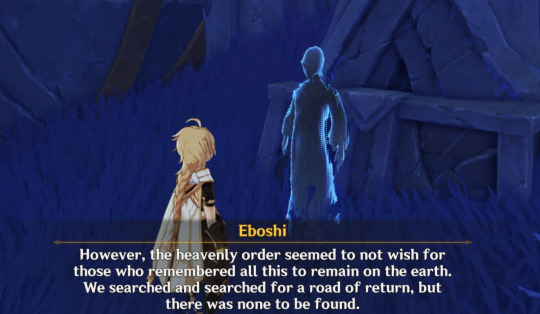
Eboshi: However, the heavenly order seemed to not wish for those who remembered all this to remain on the earth. We searched and searched for a road of return, but there was none to be found.
Remember these hologram-looking dudes? They are the Shades of Tokoyo, also known as Sinshades. They are described as afterimages of the former citizens of Byakuyakoku preserved by Istaroth’s favor, specifically those citizens’ most powerful emotions, and they are only visible during Evernight:
Eboshi: Due to the phenomenon known as Sinshades, the “past,” “history,” and “truth” of Enkanomiya would endure even if left to their own devices. Eboshi: As such, great effort was expended, not that we might remember, but that we might “forget.” Lady Sangonomiya was of this view.
Like a dream, Sinshades only appear at night, and they are a kind of embodiment of history or “truth” that Watatsumi Island has chosen to forget, representing the thoughts and emotions of those who once lived in Enkanomiya. Using Freud’s theory of dream interpretation as a framework, Enkanomiya then functions as Watatsumi Island’s unconscious mind.
Put another way, if all Sinshades are the result of strong emotions preserved in time through Istaroth’s favor, then those emotions are like thoughts, and that would make the Sinshade a “physical” form or expression of those thoughts. So, when we call the afterimages the “Sins of Tokoyo,” we are in effect calling them the “Dreams of Tokoyo,” because they are the thoughts and emotions of Enkanomiya given form, and that’s what dreams do: they convey thoughts and feelings through a series of images.
Through the Sinshades, we see an implicit association with the concepts of dreaming and sinning in Genshin’s worldbuilding, and through them we understand that they are not so different from one another.
A Brief Note on Aesthetics

Jakob: Look at your feet. Blood, flowing like a river, fertilizing the very dust of the earth with their filthy fat.
It may have struck you how various Melusine perceive reality in a way that greatly differs from the things we see, as if at times their perception was “flipped,” if not somewhat strange. By the end of Ancient Colors, it’s clear that this is due to the Melusine being born of Elynas, who is not from this world. A similar phenomenon can be seen in both Durin and Elynas, the former imagining itself dancing with the people of Mondstadt before it “woke up” from this dream to Dvalin’s fangs in its neck, and the latter realizing that the things that it finds fun are destructive and harmful to the people of this world.
This is a part of the commentary present in several world quests and commissions in Fontaine that deal with “aesthetics,” or one’s own sense of beauty. Aesthetics are principles that differ on both large and small social scales, varying between groups of people and between individuals (see Salsa’s and Ubu’s aesthetic disagreement), and they can change throughout time as values change. In other words, they are informed by perspectives.
For example, think of what we know so far about the Primordial Sea. Neuvillette wonders how the Primordial Sea could be capable of giving life and then “suddenly reversing itself” so that it instead “devours life,” but this is just his judgment of what the sea does, and ultimately his perspective. Many others view the properties of the Primordial Sea differently from him: to them, the prophecy is comforting because it signals a “return,” or a “homecoming.” To take it a step further, Neuvillette may be making an assumption by stating that the sea has reversed itself. Perhaps this is just how the sea is, perhaps this is its “truth.”

Verenata: The "truth" will not be limited or constrained by the eyes and perspectives of the viewer, and won't be distorted by what is in their heart. It objectively exists, and it just is...like the white sand, like the bones of seastars, like the waves that crash and pound...those are "truth."
Now, imagine that you are staring at a 3D object from a 90 degree angle. If I ask you to describe the object from where you're standing, you'll be able to accurately tell me about what roughly half of the object looks like, but you won't be able to accurately describe the other half of it without help from someone standing on the other side of the object.
But how can you be sure there even is another side of the object, or that it's any different from the one you see now? From your perspective, what is already visible to you may seem sufficient to describe the object in its entirety. In other words, your perspective becomes your "truth."
It is only through considering additional perspectives that we broaden our own understanding of reality and expand on our "truth." However, broadening our perspective is usually not a comfortable experience, as is typical when we engage with ideas that differ from our own. Part of expanding our "truth" requires us to shatter our current understanding, pick up the pieces, and reassemble them into a shape that makes space for these other ideas and their "truth."
For example, when we confront Jakob at Elynas' heart, he describes the rushing currents beneath our feet as Elynas' blood. To the player, who has been swimming around in that for a couple of hours by that point, this idea is macabre and horrifying. However, when we consider Jakob’s perspective, his “truth,” it also expands our understanding of Elynas as a being that is somewhere between dead and alive, sleeping if you will, and that he is more than capable of waking up from his slumber with the appropriate stimulus. Another example is Canotila, who saw the wasteland in Rene's Book of Esoteric Revelations as a peaceful forest. When we consider Canotila's "truth," her aesthetic sense doesn't change the way we see the wasteland, but it does show us something equally important: the way that we experience the wasteland is not the only way it can be experienced.
If we return to the other ever-present metaphor of alchemy as a form of painting, we can see that Rhinedottir’s aesthetic sense greatly differs from what is acceptable and compatible with Teyvat. But, just like Mamere, she paints regardless of whether her paintings are understood by a greater audience. In time, Teyvat's "aesthetics" may change again, and perhaps her "art" will be received differently when that time comes.
Concluding Thoughts

(A pool full of Water from the Primordial Sea. Countless sins were born of it…)
So, that is why I think Rhinedottir was deemed a sinner. She sinned by “dreaming” up these chaotic life forms that were not from this world, bringing them into being through the Art of Khemia, and telling those chaotic life forms that they were beautiful, too, that the ordered and lawful world of Teyvat just needed to realize how beautiful they were. Maybe Rhinedottir was dreaming of a new world, one where her children’s wishes could be fulfilled, where they could exist with everyone, and maybe creating that world required the destruction of this one. You could also think of her as someone who has introduced “external variables” into Teyvat, which, hmmm..:
“...No matter how many times I derive it, the result remains the same, though this result is not expected... Unlike the world depicted in these ancient texts, there will be no more new civilizations born... Unless we consider introducing "variables" from outside the system... If it was that sort of power, there might be a chance…” -Enigmatic Page I, Book of Esoteric Revelations
In this way, her “children” (thoughts) were all “born with sin,” or are born from sin (dreams). If Rhinedottir is a dreamer, then alchemy is the way that she dreams: it allows her to give forms to these thoughts. And if you buy that, then there are some serious implications to consider from this whole notion of Fontainians being “born with sin,” and just what exactly the Primordial Sea might be. Definitely something to think about while we wait for 4.1.
One last point that is more of an aside than anything else: Rhinedottir’s only remaining child is Albedo, but through this lens we see that he is not just the culmination of the Primordial Human Project, the creation of a human through the power of alchemy, but also the only known example of Rhinedottir’s “ideas” that coexists with Teyvat as it is now. As for her known extant grandchildren, they have integrated with Fontainian society and don’t seem to cause them any trouble. I wonder if she knew something like that could happen?
But…that’s just my take on it so far. What do you think?
(also, fun fact: there is a parallel storyline to this one unfolding in Honkai Star Rail right now as it relates to being deemed a “sinner” for creating life, and another parallel storyline in Honkai Impact 3rd about creation and rebirth and “returning home to the sea” and I just love when Hoyoverse connects their games like that)
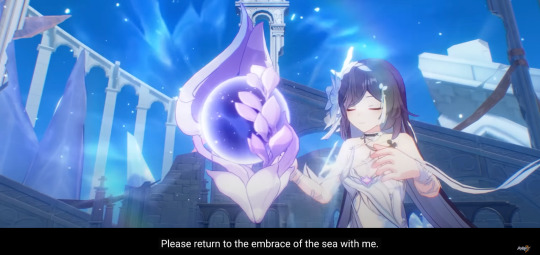
EDIT (9/8/2023): Touched this up a bit and made some grammatical corrections. Thesis is the same, some added support and re-phrasing was done to better convey it.
Sources
A General Introduction to Psychoanalysis by Sigmund Freud
#genshin impact#genshin lore#genshin impact lore#genshin theory#genshin meta#genshin impact meta#fontaine lore#rhinedottir#theory#elynas#durin#melusine#long post
264 notes
·
View notes
Text
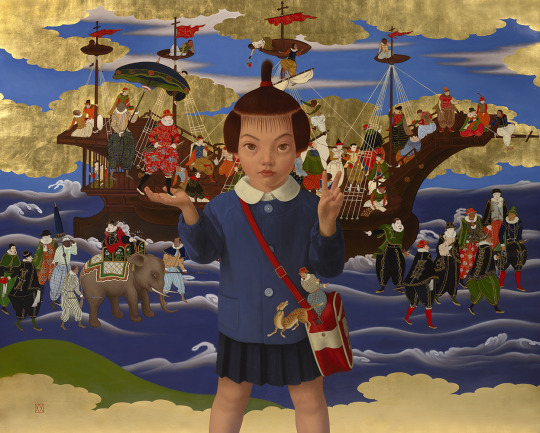


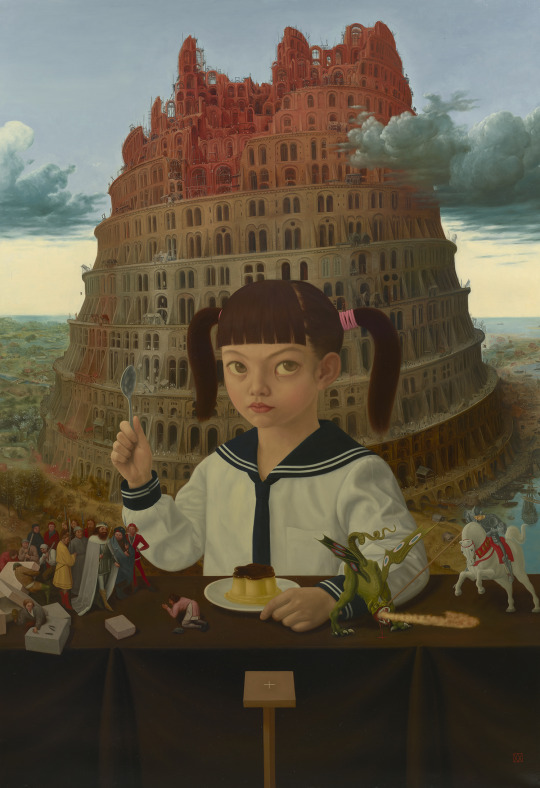
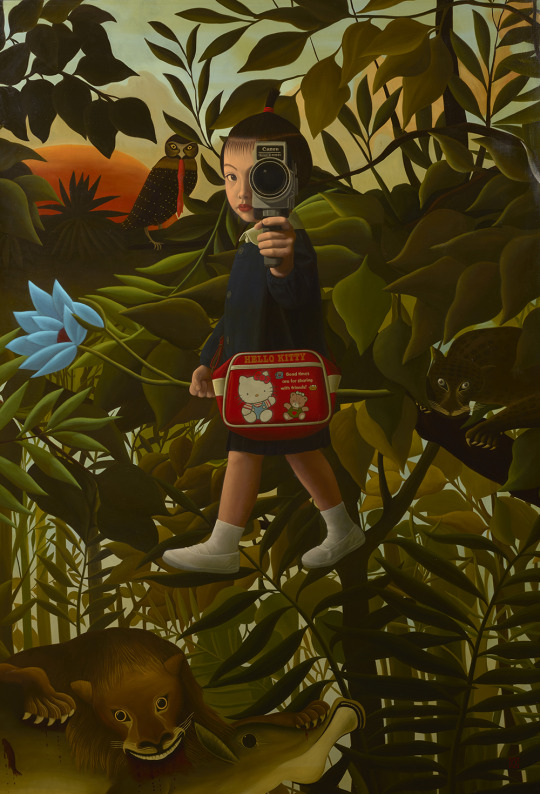
Mitsuru Watanabe, Japanese, b. 1953
Mitsuru Watanabe was born in 1953 in the Aomori Prefecture in Japan, the youngest of four siblings. His mother was an amateur painter who set an example for her children, not only with her own work, but also with an extensive library of art books in the family home. The young Mitsuru gradually began to browse through the books, thus introducing himself to a wide variety of styles, aesthetics and historical images. In addition, he poured over books on drawing and painting techniques, establishing a foundation for his future work as a professional artist.
His junior high school did offer an art class, but it was not particularly inspiring, and in high school, there was no art education offered. That left Mitsuru to study on his own, and after graduation in 1972, he again consulted art books about painting techniques, which provided some basic guidance. His introduction to professional training came as a result of an advertisement that he placed in an art magazine in the hope of attracting some clients for his painting. Instead one of his paintings was purchased by a collector on behalf of the painter Seiichiro Ban (b. 1950), who was impressed with the younger artist’s work. He invited Mitsuru to Kyoto, eventually teaching him “everything about painting techniques”, including the use of oils, brushwork and color adjustment. In the process, the two men became good friends.
Meanwhile, Mitsuru worked for a printing company for a few years. Eventually, he gave it up in order to paint, and for several years, he paid the bills by gambling at mahjong and pachinko (Japanese pinball). In spite of the hardships of such an uncertain mode of living, he looks back fondly on this period.
By 1975, he met and married his wife, and moved to Hachinohe City. The family soon grew to include a son and two daughters. Looking back on those early days, Mitsuru recalls spending many days reading in a library while taking care of his son. He requested books on philosophy, religious studies, cultural anthropology, psychoanalysis and contemporary criticism, all of which the library provided. A few years later, when his paintings were selling well, a librarian mentioned to him that they had spent over 200,000 yen per year on his requests; and that his absence from the library meant that they no longer had such a generous budget allotment.
With a growing family, Mitsuru realized that he would need to increase his income. He had become friends with a local theatrical troupe, even writing a play for the group at one point, and thought that they might be interested in purchasing some of his paintings. With these funds, he was able to organize a successful solo exhibition in Hachinohe. Ultimately, he was able to raise enough money to advertise his work in an art magazine and stage an exhibition in Ginza. Most of the paintings sold and Mitsuru’s career was launched.
In the 1980s, Japan was enjoying an economic boom, including the market for contemporary art. Although progress was slow initially, Mitsuru’s work began to attract attention in Tokyo. When he won the 10 million yen prize in the Second Ryohei Koiso Grand Prize Exhibition in 1994, the gallery world took notice. Soon he was working with a gallery in Ginza, which in turn led to Mitsuru’s art being noticed by a Hong Kong gallery; this broadened the international market for his art.
In 1990, Mitsuru met and befriended Hiroshi Furuyoshi after seeing an exhibition of his work. Hiroshi’s collection of international art books provided inspiration, and, as Mitsuru notes, Hiroshi “generously taught me about [western] painting techniques.”
His work offers a compelling mix of Japanese and Western traditions. He borrows imagery freely from a number of western artists, ranging from Pieter Brueghel and Hieronymus Bosch to Henri Rousseau. These “borrowed images” are grounded in the Japanese tradition of shyakkei (borrowed landscape) which utilizes nearby natural landmarks as the backdrop to the design of a garden. Likewise, Mitsuru incorporates traditional western images both as the stage for his work and occasionally as commentary in the form of small visual quotations from old master paintings by Peter Paul Rubens, Raphael, Michelangelo, and Erie Loran, as well as the Japanese contemporary artist Hayami Gyosyu.
Almost all of Mitsuru’s paintings feature his children as his models. In the 2018 painting, In the Forest-with Deposition of Christ, one of his daughters is shown strumming a guitar while comfortably seated in one of Henri Rousseau’s forests. The lion from Rousseau’s painting of The Sleeping Gypsy (1897) grazes casually nearby at a much smaller scale. And on the other side of the canvas, Peter Paul Rubens’ The Descent from the Cross (1612-14) is inserted into the forest landscape as if it were a staged tableau. In the 2019 painting, Naoko Walking in Rousseau’s Forest, the artist’s daughter again appears, this time walking on air with her “Hello Kitty” purse slung over her shoulder and a Canon camera pointed straight at the viewer as if it were a gun.
The combination of humor and serious cultural commentary is characteristic of Mitsuru’s painting. He notes that this too is based on an older Japanese trope, Honka-dori, in which new tanka poetry is created by quoting from famous older tanka poems. Mitsuru has used iconic western paintings coupled with very contemporary Japanese images to initiate a discussion about the cross-cultural influences of each tradition. And his children have become the ambassadors of that conversation. As Mitsuru comments “As long as I live, they will go around the world of painting as a child, like Peter Pan.”
Janet Whitmore, Ph.D.
https://rehs.com/Mitsuru_Watanabe_Naoko_Playing_in_Boschs...
18 notes
·
View notes
Text
Tag nine (9) people you’d like to know better
Tagged by @actual-pasta-overlord (thank you sm!!)
Last Song: No One Is Ever Going to Want Me - Giles Corey
Currently Watching: I finished all my series (the last ones were Skins UK and Black Mirror) so nothing atm? No wait I started "Love Exposure" and haven't finished yet, so let's say that.
Current Reading: oh boy, there will be a lot lmao (i always read a few things in parallel)
- Sacred and Terrible Air by Robert Kurvitz
- Tales of the Quantum (seriously need to finish that one) by Art Hobson
- Les Miserables by Victor Hugo
- A General Introduction to Psychoanalysis by Sigmund Freud
Current Obsession: obvious, Disco Elysco lol. More precisely that random post-apo AU I think. But there is always a place for Undertale/Deltarune in my heart too.
Tagging: uhh why make me choose ;-; so uh @amrehmar @bloodanddiscoballs @cadoava @colestner @awesomediscoclub @itsdiscobaby @markala5 @nadiasna7 @elysiicns and anyone else who wants to join (don't feel forced to do it tho, any of u) as all my mutuals are cool and lovely
9 notes
·
View notes
Text
“With words one man can make another blessed, or drive him to despair; by words the teacher transfers his knowledge to the pupil; by words the speaker sweeps his audience with him and determines its judgments and decisions. Words call forth effects and are the universal means of influencing human beings. Therefore let us not underestimate the use of words in psychoanalysis, and let us be satisfied if we may be auditors of the words which are exchanged between the analyst and his patient.” Sigmund Freud, A General Introduction to Psychoanalysis
1 note
·
View note
Text
Tag nine (9) people you’d like to know better
Tagged by @sygneth (thank uuu! Tumblr games, sure, why not)
Last Song: Play Fair - Nova Twins
Currently Watching: I'm on a marathon of various Ukrainian movies! and after this I'm going to watch new Black Mirror episodes.
Currently Reading: ughh a few books at once (and I'm not proud of it, it's hard to finish even one):
"Sacred and Terrible Air" by Robert Kurvitz
"A General Introduction to Psychoanalysis" by Sigmund Freud (it's a coincidence, Sygneth :)
Poèmes de Guillaume Apollinaire (my handbook)
"Vade-mecum" by Cyprian Kamil Norwid
"Chapterhouse: Dune" by Frank Herbert
Current Obsession: Disco Elysium. Just. Yes.
Tagging: I'm not sure who has not been tagged yet, soo
@kayderrart (oh hello c: we are mutuals on twi, won't you mind me on tumblr too hehe?), @panwithpots, @cryptiduni, @sparkfoam, @garnelenn, @celestial-dizzard
and everyone who sees this - feel free to join or just ignore, no pressure!
2 notes
·
View notes
Text
Shift in perception
Now, understanding mental health has transformed significantly from historical times to today's era. Such a transformation indicates changes within the scientific realm, cultural expressions of attitudes, and the priorities of society. Historically, most mental health issues were misunderstood, stigmatized, and due to supernatural reasons. But today, people are more aware and of accepting nature. However, challenges stay constant.
Traditionally, mental health issues have been understood by religion, mysticism, and superstition. Psychosis or depression were explained in terms of divine punishment, demonic possession, or spiritual imbalance. All treatments varied; from exorcism and rituals, there were cruel practices such as isolating and punishing the mentally unfit. For example, people with mental illnesses living in medieval Europe were often in dungeons under very horrific conditions as a form of "treatment."
There was some progress when philosophers and early scientists started to question supernatural explanations. There was Philippe Pinel in the 18th century who argued for more humane treatment and placed compassion and care over punishment. The stigma, however, continued and hence these places remained confinement rather than opening healing institutions.
The 19th and early 20th century witnessed a significant shift in looking at mental health as a medical issue rather than a moral failing. Psychiatry emerged as a distinct field, and theories of Sigmund Freud and his psychoanalysis explored the inner workings of the mind.
Public opinion had not much changed at that point. Mental illness was considered a family shame. Many mentally ill people were secluded, leaving them in even greater isolation from society, leading to worsening their condition. The media did not help. People with mental illnesses were represented as dangerous or unstable.
The mid-20th century saw significant progress in understanding and treating mental health. The introduction of medications, such as antidepressants and antipsychotics, revolutionized treatment options. The general rise of psychology as a discipline helped in popularizing discourses on mental health, although many stereotypes and myths remained.
Today, mental health is understood as a necessary component of the entire spectrum of well-being.
Neurosciences and psychology have established a more extensive understanding of the biological, psychological, and social underpinnings of mental health. Syndromes such as depression, anxiety, and schizophrenia are no longer perceived as moral or personal failures but as complex, multifaceted disorders.
Events like World Mental Health Day, along with initiatives from the WHO and the website and campaigns from Mental Health America, have increased the global awareness. Celebrities, athletes, and influencers also came forward and revealed their struggles so that it made a normal conversation around mental health.
The new generation or Gen Z has adopted cultural changes regarding mental health awareness. Social networking sites have enabled the exchange of experiences, which has reduced isolation and promoted feelings of empathy. However, this era of connectivity has led to new challenges, including cyberbullying, which often leads to mental distress.
The graph regarding the awareness of mental health has gone up with time. However, there is still a lot of stigma surrounding the topic. People, even after being aware of the issue, don't want their peers or friends to know about their struggles and want to keep their healing process a secret.
#psychotherapy#mental health#mental health awareness#changeinperception#sigmund freud#psychoanalysis#social media#cyberbullying#mental wellbeing
1 note
·
View note
Text
Foreclosure involves the radical rejection of a particular element from the symbolic order (that is, from language), and not just any element: it involves the element that in some sense grounds or anchors the symbolic order as a whole. When this element is foreclosed, the entire symbolic order is affected; as has been noted in a great deal of the literature on schizophrenia , for example, language operates very differently in psychosis from the way it does in neurosis . According to Lacan, the element that is foreclosed in psychosis intimately concerns the father. He refers to it as the " Name- of-the-Father " (as we shall see, the French, Nom-du-Pere, is far more instructive).
The absence of the paternal function is the single most important criterion to consider in diagnosing an individual as psychotic, yet it is by no means immediately visible in the majority of cases.
The paternal function is not the function played by the individual's father, regardless of his particular style and personality, the role he plays in the family circle, and so on. A flesh-andblood father does not immediately and automatically fulfill the paternal function, nor does the absence of a real, live father in any way automatically ensure the nonexistence of the paternal function. This function may be fulfilled despite the early death or disappearance of the father due to war or divorce; it may be fulfilled by another man who becomes a "father figure"; and it may be fulfilled in other ways as well.
Let it suffice to say that the father who embodies the paternal function in a nuclear family generally comes between mother and child, stopping the child from being drawn altogether to or into the mother and stopping the mother from engulfing her child. Lacan does not claim that all mothers have a tendency to smother or devour their children (though some do); rather, he says that children "perceive" their mOther's desire as dangerous or threatening. This "perception" reflects in some cases the child's wish for the mother to take her child as her be-all and end-all (which would ultimately annihilate the child as a being separate from its mother), and in other cases a reaction to a genuine tendency on the mother's part to obtain a kind of satisfaction with her child that she has not been able to obtain elsewhere.
In either case, the result is the same: the father keeps the child at a certain distance from its mother, thwarting the child's attempt to become one or remain forever one with the mother, or forbidding the mother from achieving certain satisfactions with her child , or both. Stated differently, the father protects the child from le desir de la mere ( which means both the child's desire for the mother and the mother's desire )-that is, from a potential danger. The father protects the child from the mother as desire (as desiring or as desired), setting himself up as the one who prohibits, forbids, thwarts, and protects-in a word, as the one who lays down the law at home, telling both mother and child what is allowed and what is not.
📚 A Clinical Introduction to Freud: Techniques for Everyday Practice, Psychoanalysis, Brice Fink, 2017.
0 notes
Text
Consumerism in Pop Music Through Ariana Grande's 7 Rings
Popular music, which wields significant influence over its listeners, especially the younger generation, is a prominent force today. In this critical reflection, I will employ the social learning theory developed by psychologist Albert Bandura (1977) to explore how pop music fosters consumerism among its audience through identity shaping.
To begin, I will delve deeper into three problems: Social learning theory; pop music, consumerism, and their connections to personal identity.
First, social learning theory, developed by psychologist Albert Bandura as an alternative to behaviorism, posits that individuals acquire social behavior by observing and imitating others. This theory relies on four mediational processes to determine the adoption of new behaviors. (1) Attention, (2) Retention, (3) Reproduction, and (4) Motivation. Observers weigh the rewards and punishments associated with the behavior to decide whether to imitate it.
Second, music possesses the capability to elicit emotions, forge connections, and mold our identities. Throughout our lives, music has also held a meaningful role in molding our sense of self. It starts with the tunes that accompany us during our developmental stages and extends to the songs that resonate with our life's journey.
Third, consumerism is the notion that an individual's overall well-being and contentment depend on acquiring consumer products and material possessions (Hayes). Consumerism has been proven to have a significant relationship with personal identity. Research published in the peer-reviewed journal International Forum of Psychoanalysis indicates that contemporary purchasing decisions are more influenced by a product's psychological value than its practical usefulness.
In 2019, Ariana Grande released "7 Rings”, a chart-topping hit that ignited conversations about materialism within pop culture (Gaillot, 2021). The song stirred up discussions about materialism, a theme as commonplace in pop music as money not being able to buy love. Grande’s got a point that buying things can, unfortunately, feel absolutely amazing. But many people have criticized the idea that material possessions are a form of self-care. “7 Rings” may have been inspired by Grande’s attempt at self-care, but it quickly became a commercial product that reflects and promotes consumerism.

According to the social learning theory formulated by psychologist Albert Bandura, it is clear that the audience can easily imitate the behaviors and attitudes portrayed in songs. Listeners may absorb the connection between consumerism and empowerment in songs like Ariana Grande's "7 Rings."
An illustrative instance of this influence is evident on platforms such as TikTok, where users often employ the phrase "I see it, I want it, I got it" to showcase their material belongings, therefore reinforcing the idea that consumption equates to empowerment. As a result, this notion becomes more entrenched in our society, thereby fostering the fallacy that empowerment is intrinsically associated with shopping. It is imperative to acknowledge that there exist different avenues to empowerment. However, these may receive varying degrees of media exposure, notably in pop music, resulting in individuals remaining oblivious to these alternatives and unable to acquire knowledge from them.
In conclusion, understanding the connection between pop music, consumerism, and identity is essential. It is not a matter of labeling it as inherently good or bad but rather about raising awareness of this relationship.
REFERENCES
Bandura, A. (1977). Social learning theory. Prentice-Hall.
Gaillot, A. D. (2021). Pop music sold us on consumerism, one single at a time. VoxMedia. https://www.vox.com/the-goods/22585138/pop-music-consumerism
Hayes, A. Consumerism Explained: Definition, Economic Impact, Pros & Cons. Investopedia.
Introduction to Social Learning Theory in Social Work. Online MSW Programs. https://www.onlinemswprograms.com/social-work/theories/social-learning theory/
The International Federation of Psychoanalytic Societies. Taylor & Francis
1 note
·
View note
Text

Need more book recs and BTS content? You’re in luck! We’re looking back at five books SUGA has read and recommended to ARMY!


Almond - by Sohn Won-Pyung
Back in 2020, both RM and SUGA read this YA novel during In The Soop. The story centers around a young boy named Yunjae who was born with Alexithymia, a condition that makes it difficult to process certain emotions. After a tragic incident, Yunjae’s loving home is shattered, and he is left on his own. However, when Yunjae and his bully, Gon, realize they have a lot in common (and a lot to learn from each other), they form an unlikely bond. The novel focuses on the impact that love and friendship can have on one’s life.
Reinventing Your Life - by Janet S. Klosko and Jeffrey E. Young
Seen walking out of Bang Bang Con with this book, SUGA has quite a few psychological reads that he’s shared. This one in particular deals with identifying damaging patterns and “life traps”. It asks the reader to look at their relationships with themselves as well as with others. Written by renowned American psychologists using case studies, this self-help book is informative and thought-provoking.


Interpretation of Dreams - by Sigmund Freud
In the same vein as psychological books, SUGA has also expressed that he has also read General Introduction to Psychoanalysis by Freud. In this work specifically, Freud discusses how dreams are the mind’s “unconscious wishes.” In the Vlive where he mentioned these works, SUGA explained how he is aware that many of Freud’s claims have been refuted, but he believes it is beneficial to understand the origins of these theories.
The Courage To Be Disliked - by Ichiro Kishimi, Fumitake Koga
During the second season of In the Soop, SUGA is seen reading this philosophical book. Alfred Adler was one of the fathers of 19th-century psychology, alongside Freud. The authors examine his theories and express how people’s futures can be changed if they let go of what has happened in their pasts or how they will be perceived. It focuses on having the courage to change and be free from the boundaries one puts on themselves.

The Alchemist - Paulo Coelho
For years, Yoongi has been recommending The Alchemist to us, whether it be for the 5th ARMY kit or on their fancafe. The author, Paulo Coehlo, acknowledged this and even sent the group signed copies of the book! The novel centers around Santiago, a young Andalusian boy journeying from Spain to Egypt to find buried treasure. During his travels, he is helped by a “king”, a Romany woman, and an alchemist. The story takes an introspective and emotional look at oneself and the journey to achieving their dream.
1 note
·
View note
Text
Decoding the Psyche: The World Through Sudhir Kakar's Lens
Introduction
When it comes to understanding the intricate dance between culture and psychology, Sudhir Kakar stands as a towering figure. Renowned for his pioneering work in psychoanalysis within the Indian context, Kakar has seamlessly woven together the threads of Western psychology and Eastern mysticism. His explorations of identity, sexuality, and spirituality have offered profound insights into the human psyche. But who exactly is Sudhir Kakar, and why is his work so significant?

The Man Behind the Insights
Early Life and Academic Pursuits
Sudhir Kakar's journey into the realm of psychoanalysis wasn't straightforward. Born in 1938 in Nainital, India, Kakar initially pursued a degree in mechanical engineering. Yet, it wasn't long before he pivoted towards psychology, a field that would eventually define his career. After obtaining his PhD from the University of Vienna, he trained in psychoanalysis under the guidance of noted analysts, gaining a deep understanding of both Freudian and Jungian theories.
Bridging Cultures
Kakar's unique position as an Indian psychoanalyst allowed him to bridge the gap between Eastern and Western psychological paradigms. He often highlighted how Western theories could not be directly transplanted into the Indian context without considering the cultural nuances. His work offered a fresh perspective, arguing that Indian society's collective and familial nature significantly influenced individual psychology.
Groundbreaking Works and Themes
The Inner World: A Psycho-Analytic Study of Childhood and Society in India
One of Kakar's seminal works, "The Inner World," delves into the psychological development of Indian children. He explores how family dynamics, social hierarchies, and religious beliefs shape the inner lives of Indian individuals. The book sheds light on the complexities of growing up in a culture where communal identity often takes precedence over individualism.
Exploring Sexuality and Gender
Kakar has extensively studied sexuality, a topic often shrouded in taboo in Indian society. In "Intimate Relations: Exploring Indian Sexuality," he navigates the intricate landscape of sexual norms, desires, and transgressions. His candid discussions challenge the traditional reticence surrounding sex, opening up conversations about the psychological implications of sexual repression and liberation.
Spirituality and Psychoanalysis
In works like "Shamans, Mystics, and Doctors: A Psychological Inquiry into India and Its Healing Traditions," Kakar examines the intersection of spirituality and mental health. He argues that Indian healing practices, often dismissed by Western medicine, hold significant psychological value. His insights into the role of gurus, shamans, and mystics reveal how spiritual guidance can complement psychological healing.
Impact on Modern Psychology
Redefining Psychoanalysis in India
Sudhir Kakar's contributions have been instrumental in redefining psychoanalysis in India. By incorporating cultural context into his analyses, he has paved the way for a more holistic understanding of mental health. His work encouraged psychologists to consider cultural background as a crucial factor in their practice, promoting a more empathetic approach to therapy.
Influence on Contemporary Thinkers
Kakar's interdisciplinary approach has influenced a generation of scholars and practitioners. His ability to blend psychoanalytic theory with cultural studies has inspired researchers to adopt a more integrated perspective. His works are frequently cited in academic circles, and his theories continue to resonate with those exploring the interplay between culture and psyche.
Frequently Asked Questions (FAQs)
Who is Sudhir Kakar?
Sudhir Kakar is an Indian psychoanalyst and writer known for his work on the intersection of psychology and culture. He has authored numerous books exploring various aspects of human behavior, particularly within the Indian context.
What are some of Sudhir Kakar's notable works?
Some of Kakar's notable works include "The Inner World," "Intimate Relations," and "Shamans, Mystics, and Doctors." These books explore themes such as childhood development, sexuality, and spirituality.
How has Sudhir Kakar influenced modern psychology?
Kakar has significantly influenced modern psychology by integrating cultural context into psychoanalytic theory. His work encourages a more empathetic and holistic approach to understanding mental health, particularly in non-Western societies.
What makes Sudhir Kakar's approach unique?
Kakar's approach is unique because he combines Western psychoanalytic theory with Eastern cultural insights. This interdisciplinary method allows for a deeper understanding of how cultural factors influence psychological development and behavior.
Sudhir Kakar's Legacy
Cultural Sensitivity in Therapy
One of Kakar's lasting legacies is the emphasis on cultural sensitivity in therapeutic practices. He has shown that effective therapy must consider the client's cultural background, beliefs, and values. This approach fosters a more inclusive and understanding environment for psychological healing.
Expanding the Boundaries of Psychoanalysis
Kakar's work has expanded the boundaries of traditional psychoanalysis, incorporating elements of anthropology, sociology, and religious studies. This multidisciplinary approach has enriched the field, providing a more comprehensive understanding of the human condition.
Continuing the Conversation
Kakar's influence extends beyond his written work. He continues to engage with the academic and therapeutic communities, offering insights and guidance. His ongoing contributions ensure that the dialogue between culture and psychology remains vibrant and evolving.
Conclusion
Sudhir Kakar's work has left an indelible mark on the field of psychology. By bridging the gap between Eastern and Western perspectives, he has offered a richer, more nuanced understanding of the human psyche. His explorations into childhood, sexuality, and spirituality challenge conventional wisdom and open up new avenues for inquiry. As we continue to navigate the complexities of mental health in a globalized world, Kakar's insights remind us of the importance of cultural context in understanding ourselves and others. His legacy will undoubtedly continue to inspire and inform future generations of scholars and practitioners.
0 notes
Text
In Mourning and Melancholia, Freud describes the melancholic as someone who cannot let go of a lost object. To Freud, an “object” is not necessarily a thing. An object, in psychoanalysis, generally refers to a person in your life who holds a significant place in your development. Your mother is an object, as is your father (or other mother, or grandparent, or whomever raised you). That “object” is taken in by you when you are developing and growing a “self”. We assemble our sense of self in part based on the objects we can take in around us. Those objects, like all people, will die. They will change. They will expose themselves to be not what (or who) you thought them to be. When we cannot mourn or grieve the loss of a person, or the loss of who we thought that person was, either because they’ve died or because of a change in our own awareness or life circumstance, then we can become melancholic and depressed. We hold on to something we wish could still exist because the pain of letting go would be too shattering to our idea of ourselves and our world.
It is often the melancholic, or in more present-day terms, the person who is depressed, who has a tendency toward suicide. Freud compared the narcissist to the melancholic by saying that for both types of people, there exists a deep and intense self-absorption. This is not a judgment; it is more of a descriptor, that in both cases, the person cannot really engage fully with the outside world. The difference between someone who is narcissistic and someone who is depressed, though, has to do with this “object” that they have internalized. For a depressed person, the object is so important to them that it has become the same as themselves. That’s how badly a person does not want to (is not able to) let go of that object and wants to hold on tight: they overlay the object onto themselves, as though they in fact are that object. This way, in an unconscious fantasy, the object (person) will never die. (Keep in mind that the object does not actually have to die, it simply has to betray you.)

https://www.mollymerson.com/blog/problems-of-suicide-freud
https://pubmed.ncbi.nlm.nih.gov/914450/
https://guilfordjournals.com/doi/abs/10.1521/prev.89.6.889.22099?journalCode=prev
https://www.theatlantic.com/health/archive/2014/09/how-sigmund-freud-wanted-to-die/380322/
Suicide, which in Lacanian psychoanalysis is considered as an act of the subject when s/he experiences himself or herself as waste (Le sinthome 2005), as a wish to take a step off stage (Britzolakis), needs to be at the centre of, rather than shunned from, the reading of Plath's work.
"Perhaps when we find ourselves wanting everything, it is because we are dangerously near to wanting nothing."
"I like people too much or not at all. I've got to go down deep, to fall into people, to really know them.“
"How we need another soul to cling to, another body to keep us warm. To rest and trust; to give your soul in confidence: I need this, I need someone to pour myself into.“
Sylvia Plath
https://journals.openedition.org/erea/6063?lang=en#:~:text=Suicide%2C%20which%20in%20Lacanian%20psychoanalysis,the%20reading%20of%20Plath's%20work.
https://esource.dbs.ie/handle/10788/3095
Kurt Cobain’s Suicide Note
To Boddah
Speaking from the tongue of an experienced simpleton who obviously would rather be an emasculated, infantile complain-ee. This note should be pretty easy to understand
All the warnings from the punk rock 101 courses over the years, since my first introduction to the, shall we say, ethics involved with independence and the embracement of your community has proven to be very true. I haven't felt the excitement of listening to as well as creating music along with reading and writing for too many years now. I feel guilty beyond words about these things
For example when we're back stage and the lights go out and the manic roar of the crowds begins, it doesn't affect me the way in which it did for Freddie Mercury, who seemed to love, relish in the love and adoration from the crowd which is something I totally admire and envy. The fact is, I can't fool you, any one of you. It simply isn't fair to you or me. The worst crime I can think of would be to rip people off by faking it and pretending as if I'm having 100% fun. Sometimes I feel as if I should have a punch-in time clock before I walk out on stage. I've tried everything within my power to appreciate it (and I do, God, believe me I do, but it's not enough). I appreciate the fact that I and we have affected and entertained a lot of people. I must be one of those narcissists who only appreciate things when they're gone. I'm too sensitive. I need to be slightly numb in order to regain the enthusiasms I once had as a child
On our last 3 tours, I've had a much better appreciation for all the people I've known personally, and as fans of our music, but I still can't get over the frustration, the guilt and empathy I have for everyone. There's good in all of us and I think I simply love people too much, so much that it makes me feel too fucking sad. The sad little, sensitive, unappreciative, Pisces, Jesus man. Why don't you just enjoy it? I don't know!
I have a goddess of a wife who sweats ambition and empathy and a daughter who reminds me too much of what I used to be, full of love and joy, kissing every person she meets because everyone is good and will do her no harm. And that terrifies me to the point to where I can barely function. I can't stand the thought of Frances becoming the miserable, self-destructive, death rocker that I've become
I have it good, very good, and I'm grateful, but since the age of seven, I've become hateful towards all humans in general. Only because it seems so easy for people to get along that have empathy. Only because I love and feel sorry for people too much I guess
Thank you all from the pit of my burning, nauseous stomach for your letters and concern during the past years. I'm too much of an erratic, moody baby! I don't have the passion anymore, and so remember, it's better to burn out than to fade away.
Peace, love, empathy
Kurt Cobain
Frances and Courtney, I'll be at your altar
Please keep going Courtney, for Frances
For her life, which will be so much happier without me
I LOVE YOU, I LOVE YOU
https://youtu.be/1YhR5UfaAzM
1 note
·
View note
Text
A. In the filigree of the dream, experience solely as transcribed in
literature
philosophy
mysticism
one can discern already an anthropological significance of the dream.
This [anthropological significance] is the very significance that Binswanger tried to retrieve from another angle, in a completely different style of analysis, in "Dream and Existence." We do claim
not to either to summarize it or to gloss it
but only to show to what extent his work can contribute to an anthropology of the imagination
1. The anthropological analysis of a dream uncovers more layers of significance than the Freudian method implies.
a. Psychoanalysis explores only one dimension of the dream universe, that of its symbolic vocabulary, which from beginning to end transmutes a determining past into a present that symbolizes it.
i. The polysemantic character of the symbol defined by Freud as "overdetermination" doubtless complicates this scheme and gives it a wealth that reduces the element of arbitrariness.
ii. All the same, this plurality of symbolic magnifications does not generate a new axis of independent meanings. Freud sensed the limits of his analysis and perceived the need to go further. Often he came upon signs of the dreamer situated within the oneiric drama,
as if it did not stop at symbolizing and telling in images a history of earlier experiences
as if the dream circled about the whole existence of the subject to restore its dramatic essence in theatrical form
– Michel Foucault, Dream, Imagination and Existence: An Introduction to Ludwig Binswanger's Le rêve et l'existence (part IV: Ce qui pèse to l'homme, c'est le rêve [What weighs on man is the dream] — Bernanos), 1954, translated by Forrest Williams
0 notes
Link
Check out this listing I just added to my Poshmark closet: Hergenhahn's an Introduction to the History of Psychology
0 notes
Text
5 essential modern art painting styles everyone must know

Introduction
Modern art painting is a broad term that refers to the creative movements and styles that evolved in the late nineteenth and early twentieth centuries, which were distinguished by a rejection of old artistic conventions and a concentration on experimentation, creativity, and personal expression.
Modern art painting spans a vast range of styles, techniques, and mediums, ranging from Impressionism and Cubism to Abstract Expressionism and Pop Art, representing the diverse and fast-changing world of the twentieth century. Painting in modern art pushed the boundaries of what was considered "art" and who could create it, creating new avenues for artistic expression and cultural interchange.
Abstract art: Abstract art is a type of visual expression in which colours, shapes, and textures are used to produce a non-representational image. It's like a visual symphony that captures the attention of the viewer and urges them to join in on the creative process. Abstract art can evoke emotions, conjure memories, and inspire new ideas while challenging traditional artistic standards.
Pop art: Pop art is a modern art style that arose in the 1950s and 1960s and is distinguished by the use of bright colours, graphic patterns, and imagery from popular culture, such as comic books, ads, and consumer products. Pop art highlighted common items and experiences, defying established notions of what art should be and who it should appeal to. Pop art's irreverent and joyful character continues to inspire contemporary art and design today.
Postmodern art: Postmodernism is a late-twentieth-century art movement that challenged traditional definitions and traditions of art. Postmodern art is characterised by a wide range of styles, techniques, and mediums that often combine parts from different times in history and different cultures.
Postmodern artists reject the concept of objective truth or universal narrative in favour of a diversity of opinions and ideas. Irony, parody, and satire are frequently used to criticise established institutions and power systems while also enjoying popular culture and everyday experiences. Postmodern art can be both playful and provocative, reflecting current society's complexity and fragmentation.
Surrealism art: Surrealism is a subgenre of modern art painting that arose in the 1920s and 1930s and is distinguished by surreal and magical imagery that questions established concepts of reality and rationality. Surrealist painters aimed to investigate the world of dreams by tapping into the subconscious mind and adding weird and unexpected juxtapositions of items and figures to generate a sense of disorientation and surprise.
Several of their works contain symbolic and allegorical elements, as they were influenced by Freudian psychoanalysis and the study of the human mind. Surrealism is noted for its vivid and often disturbing imagery, which can be both playful and scary, and has left an indelible mark on the art world and popular culture.
Expressionism art: Expressionism is a style of modern art painting that arose in the early twentieth century and is distinguished by the use of bright colours, powerful brushstrokes, and emotional intensity to communicate a subjective and personal image of the world. Expressionist artists used their paintings to represent their inner feelings and experiences, frequently distorting reality and employing abstract forms to convey a sense of emotion and turmoil.
They abandoned conventional concepts of beauty and realism in favour of a more raw and spontaneous approach to painting. Expressionism is noted for its vivid and often disturbing imagery, which can be very personal as well as universal in appeal.
Top modern art paintings you can buy from Satguru’s
Satguru’s is a well-known decor shop based in Mumbai. They have an amazing collection of paintings, both traditional Indian paintings and modern art paintings, that can elevate the beauty of your house.
Red Abstract Small: This painting is filled with beautiful colours and is sure to add life to your space. It can be the perfect painting for your living room or your office cabin.
Abstract 7 horses: A feng shui lucky seven horses image in your home is thought to ensure financial stability in your life. And having it in your office guarantees job advancement as well as company success.
Abstract Cut Painting: This gorgeous abstract artwork is sure to add colour and energy to your home, and it provides a touch of contemporary style with attractive geometric figures.
Men in Line: This piece is mostly figurative, with a single centre person taking up the full canvas. It also incorporates subtle textures, lending this artwork a distinct appeal. It can be the perfect handmade painting for your living room.
Conclusion
Modern art painting is not bound by any rules and continues to evolve to this day. Modern art painting has had a major impact on how we view and understand art since it has questioned traditional beauty and realism standards. While modern art painting has received criticism and controversy, it has provided artists with new avenues to explore and express themselves. Overall, modern art painting continues to be a strong and dynamic force in the art world, inspiring, challenging, and provoking new ways of thinking about art and creativity.
At Satguru’s there is something for every occasion. You can buy dinnerware, wall art, god idols, and home decor items. Visit their website to learn more about their services.
#OnlineGiftShops#giftshopsonline#satgurus#modernIndianpaintings#modernIndianpaintingsonline#modernIndianpaintingssatugurus#Indianpaintingsportray#onlineartstore#onlineartstoresatgurus
0 notes